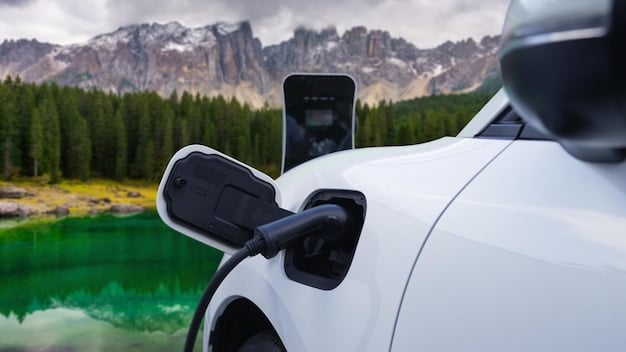Solid-State Batteries: Doubling EV Range, Ending Range Anxiety by 2025

Electric Vehicle Range Anxiety Solved? Solid-State Battery Technology is poised to revolutionize the EV industry by potentially doubling the range of electric vehicles by late 2025, offering a solution to one of the most significant barriers to EV adoption: range anxiety.
Are you Electric Vehicle Range Anxiety Solved? Solid-State Battery Technology Set to Double Electric Vehicle Range by Late 2025. This innovation promises to alleviate a major concern for potential EV buyers: the fear of running out of charge before reaching their destination.
The Challenge of Electric Vehicle Range Anxiety
Electric vehicles have steadily gained popularity, offering a greener alternative to traditional gasoline cars. However, one persistent issue continues to plague potential EV adopters: range anxiety. This concern about the limited distance an EV can travel on a single charge has been a significant barrier.
Range anxiety isn’t just a hypothetical problem; it’s a real psychological hurdle for many drivers. It affects how people plan their trips, where they choose to drive, and even their overall satisfaction with their electric vehicle.
Understanding Range Limitations
Several factors contribute to an EV’s range limitations. Battery capacity is the most obvious one, but driving habits, weather conditions, and even the terrain can impact how far an EV can travel on a single charge.
- Driving Style: Aggressive driving, such as rapid acceleration and hard braking, consumes more energy and reduces range.
- Weather Conditions: Cold weather can significantly decrease battery performance, leading to reduced range.
- Terrain: Driving uphill requires more energy, while driving downhill can provide some regenerative braking, slightly increasing range.
- Accessing Charging Stations: The anxiety or concern about the amount of time required to access charging stations.
Solving range anxiety requires not only increasing battery capacity but also improving charging infrastructure and providing drivers with accurate and reliable range estimations.
Solid-State Batteries: A Potential Game Changer
Enter solid-state battery technology, a promising innovation that could revolutionize the electric vehicle industry. Unlike traditional lithium-ion batteries, solid-state batteries use a solid electrolyte instead of a liquid one. This seemingly small change has profound implications for battery performance, safety, and energy density.
Several companies and research institutions are actively developing solid-state battery technology, and the race to commercialization is heating up. If successful, solid-state batteries could pave the way for EVs with significantly longer ranges, faster charging times, and improved safety features.

Advantages of Solid-State Batteries
Solid-state batteries offer several key advantages over their lithium-ion counterparts. These advantages address some of the most pressing concerns regarding EV performance and safety.
- Higher Energy Density: Solid-state batteries can store more energy for a given size and weight, leading to longer driving ranges.
- Improved Safety: The solid electrolyte is less flammable than the liquid electrolyte, reducing the risk of fire or explosion.
- Faster Charging Times: Solid-state batteries have the potential to charge much faster than lithium-ion batteries, minimizing downtime.
- Greater Stability: Solid Electrolytes make Solid-State batteries more durable and long lasting then their Lithium-Ion counterparts.
These advantages make solid-state batteries an attractive alternative to traditional lithium-ion batteries, potentially transforming the EV landscape.
Timeline for Solid-State Battery Deployment: Late 2025
One of the most exciting aspects of solid-state battery technology is the projected timeline for its deployment. Many industry experts believe that solid-state batteries could be ready for mass production and integration into electric vehicles by late 2025. This ambitious goal reflects the significant progress made in recent years.
While challenges remain, the momentum behind solid-state battery development is undeniable. Automakers, battery manufacturers, and research institutions are investing heavily in this technology, signaling a strong belief in its potential.
Key Players in Solid-State Battery Development
Several companies are at the forefront of solid-state battery development. Each company brings unique expertise and approaches to the challenge.
- Toyota: Toyota has been a long-time advocate of solid-state battery technology and aims to launch EVs with solid-state batteries in the coming years.
- QuantumScape: QuantumScape is a startup focused exclusively on solid-state battery development and has partnered with Volkswagen.
- Solid Power: Solid Power is working with multiple automakers, including Ford and BMW, to develop and commercialize solid-state batteries.
These companies, among others, are driving innovation and pushing the boundaries of solid-state battery technology.

Doubling Electric Vehicle Range: A Realistic Possibility?
One of the most significant claims surrounding solid-state batteries is their potential to double the range of electric vehicles. While this may seem like an ambitious promise, several factors support its feasibility.
The higher energy density of solid-state batteries allows for a more compact and lightweight battery pack, which can significantly increase the range of an EV. Additionally, the improved safety characteristics of solid-state batteries may allow for more aggressive battery designs, further boosting energy storage capacity.
Factors Influencing Range Increase
While doubling EV range is a realistic possibility with solid-state batteries, several factors will influence the actual range increase achieved.
- Battery Chemistry: The specific materials used in the solid-state battery will impact its energy density and performance.
- Vehicle Design: The overall design of the electric vehicle, including its aerodynamics and weight, will affect its energy consumption and range.
- Driving Conditions: As with any battery technology, driving conditions such as temperature, speed, and terrain will play a role in determining the actual range achieved.
Taking this into account, Solid-State batteries could have an overall lasting impact on the EV marketplace.
Addressing Cost and Scalability Challenges
While solid-state battery technology holds immense promise, it’s essential to acknowledge the challenges that remain. Cost and scalability are two of the most significant hurdles to overcome before solid-state batteries can become widely adopted.
Currently, solid-state batteries are more expensive to manufacture than traditional lithium-ion batteries. This is primarily due to the cost of the solid electrolyte material and the complex manufacturing processes required.
Currently solid-state batteries, may need to rely on the cost of the solid electrolyte when planning manufacturing processes.
Strategies for Reducing Costs
Fortunately, several strategies are being pursued to reduce the cost of solid-state batteries and improve their scalability.
- Materials Research: Scientists are actively researching new and more affordable materials for the solid electrolyte.
- Manufacturing Innovations: Companies are developing innovative manufacturing techniques to streamline production and reduce waste.
- Economies of Scale: As production volumes increase, economies of scale will help drive down the cost of solid-state batteries.
Over time, as technology matures and production scales up, the cost of solid-state batteries is expected to decrease significantly, making them more competitive with lithium-ion batteries.
The Impact on Charging Infrastructure
The advent of solid-state batteries could also impact charging infrastructure. With the potential for faster charging times, solid-state batteries could reduce the demand for high-power charging stations.
If EVs can charge significantly faster, drivers may be less reliant on ultra-fast charging stations and more likely to charge at home or at standard public charging points. This could reduce the strain on the charging infrastructure and make EV ownership more convenient.
Adapting to Faster Charging Times
However, even with faster charging times, a robust and reliable charging infrastructure will remain essential for widespread EV adoption.
- Expanding Charging Networks: Continued investment in expanding charging networks is crucial to alleviate range anxiety and support EV growth.
- Upgrading Existing Infrastructure: Existing charging stations may need to be upgraded to support the faster charging capabilities of solid-state batteries.
- Smart Charging Solutions: Smart charging solutions can help optimize the use of charging infrastructure and reduce energy consumption.
The need to focus on what is best for the environment and the user is important when determining the future for charging.
The Future of Electric Vehicles with Solid-State Batteries
In conclusion, solid-state battery technology holds immense promise for the future of electric vehicles. With the potential to double EV range, improve safety, and reduce charging times, solid-state batteries could revolutionize the EV industry and accelerate the transition to sustainable transportation.
The timeline for solid-state battery deployment is rapidly approaching, with many experts predicting mass production by late 2025. While challenges remain, the momentum behind this technology is undeniable, and the potential benefits are too significant to ignore.
If successful, solid-state batteries could pave the way for a new era of electric vehicles that are more convenient, affordable, and sustainable than ever before.
| Key Point | Brief Description |
|---|---|
| ⚡ Extended Range | Solid-state batteries could double electric vehicle range. |
| 🛡️ Improved Safety | Safer due to non-flammable solid electrolyte. |
| ⏱️ Faster Charging | Potential for significantly faster charging times. |
| 💰 Cost Challenges | Reducing manufacturing costs is a key challenge. |
FAQ
▼
Solid-state batteries use a solid electrolyte instead of the liquid or polymer gel found in lithium-ion batteries, potentially offering higher energy density, improved safety, and faster charging times.
▼
Key advantages include higher energy density (longer range), improved safety (less flammable), faster charging times, and increased lifespan compared to traditional lithium-ion batteries.
▼
Many experts anticipate that solid-state batteries will begin to appear in electric vehicles by late 2025, although the exact timeline may vary depending on technological advancements and manufacturing scalability.
▼
Initially, solid-state batteries are expected to be more expensive than lithium-ion batteries. However, as production scales up and technology improves, costs are projected to decrease, making them more competitive.
▼
Yes, one of the most significant benefits of solid-state batteries is their potential to significantly increase EV range, which could help alleviate range anxiety and make electric vehicles more appealing to a wider audience.
Conclusion
The arrival of solid-state battery technology could revolutionize the electric vehicle market by resolving range anxiety and improving overall performance. As we approach the anticipated deployment date in late 2025, continuous innovation and strategic investments will be crucial for realizing the full potential of this transformative technology. The future of electric vehicles looks promising, with solid-state batteries paving the way for greater adoption and sustainability.





